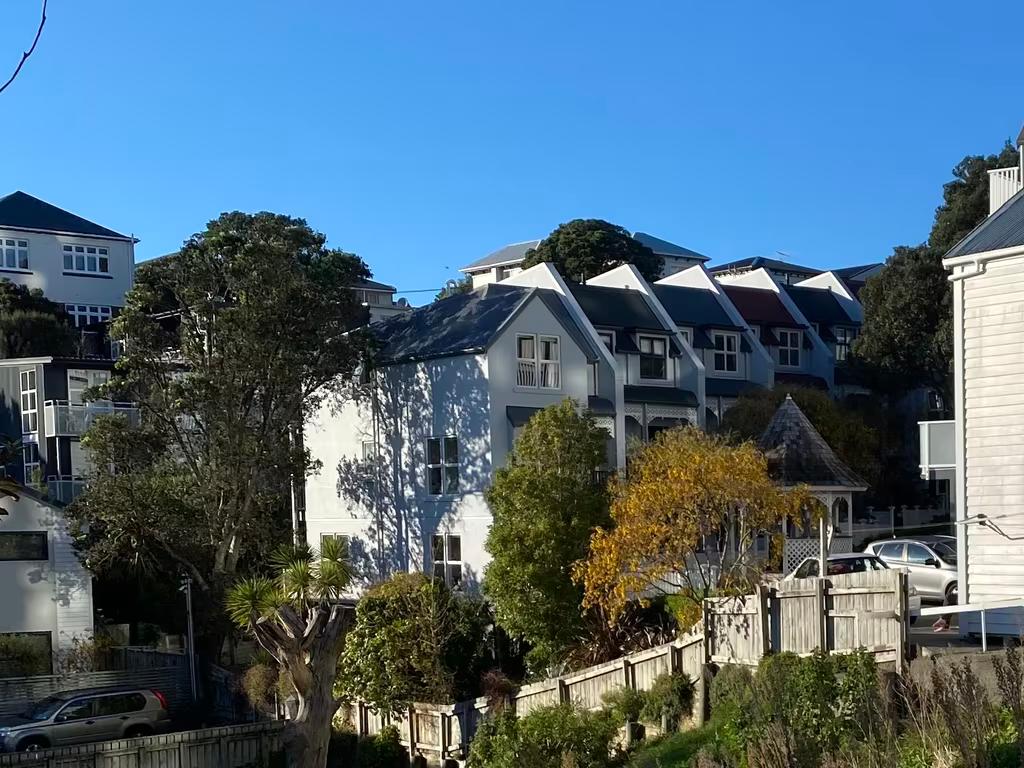
Townhouses are here to stay
Townhouse consents in the last 12 months have reached a record 42% of all new dwelling consents, up from less than 6% of all new consents in late 2012. This phenomenal growth over the last decade has been underpinned by a combination of deteriorating housing affordability and more relaxed planning and zoning regulations. Buyer preferences and perceptions have also changed, meaning that townhouses and terraced housing are not seen to be as inferior as they were in previous years.
Affordability underlines the appeal of townhouses
The affordability aspect of attached dwellings cannot be overstated. Since September 2012, the median sale price for sections has lifted from $175,000 to $375,000 (see Chart 1), while the median size of new sections1 being created has shrunk from around 570m2 to about 390m2 (see Chart 2).
The price of a section is not a simple function of the land size, but also reflects an expectation of how many homes the land could support, as well as certain fixed costs around development contributions and the provision of services, such as water and electricity, to the property. If we assume these fixed costs make up $60,000 of the section price, then the “normal” 570m2 section from 2012 could be costing buyers as much as $517,000. Cutting the average new section size by about 30% over the last decade has shaved $140,000 off the value of the land component for people looking to buy a new home and land package.
The other saving from townhouses comes from a lower overall build cost. Over the last year, the average dwelling value for new townhouse consents was $292,000, almost half the $553,000 recorded for standalone houses. Taken in tandem with the shrinking section size, this difference means that an average new townhouse with land might cost $667,000, compared to about $1,071,000 for an average new standalone house with land.2 If you’re trying to get onto the housing ladder, there’s simply no comparison between the two numbers.
Smaller and cheaper dampens growth in building activity
The change in the mix of new residential building has important implications for suppliers and other firms in the construction industry as well. Chart 3 compares the annual value of new dwelling consents in 2009/10 prices against what it would be if the average value of all new consents was equal to the value of the average new standalone house consent. It shows that if the mix of consents had not changed between 2011 and 2022, growth in the inflation-adjusted value of activity would have totalled 270% rather than 223%. In other words, about one fifth of the possible growth in activity stemming from higher consent numbers has been lost because of cheaper homes being built.
This “lost” growth is reinforced by Chart 4, which compares the annual total floor area of new dwelling consents against what that total would be if all new dwellings were the size of new standalone houses. As townhouses have made up an increasingly large share of new dwelling consents over recent years, their smaller average floor area (109m2 in the last year, compared to 194m2 for standalone houses) has dampened growth in the total volume of construction.
Of course, either the total value or total floor area of work are only proxies for how individual businesses are affected by the trend. The growth in attached dwellings will have significantly different effects on roofing, cladding, windows, plasterboard, carpet, electrical, or plumbing work, for example, with other factors such as the area of attached walls and the number of storeys also determining demand for some of these products to a greater or lesser extent.
Auckland leads the way, but isn’t the whole story
Auckland unsurprisingly leads the way in terms of new attached dwellings, with townhouses making up 58% of new consents over the last year and apartments a further 16%. The Wellington Region, with its land constraints, is not far behind, with townhouses and apartments representing 41% and 20% shares of new dwellings respectively over the last year.
What is perhaps most remarkable is the growing share made up by townhouses in provincial centres and even some regions we would typically think of as more rural. For example, as Chart 5 shows, townhouses made up 14-21% of new dwelling consents in Hawke’s Bay, Manawatū-Whanganui, Marlborough, and West Coast over the last year, up from just 3-6% in the year to September 2012, when the share of townhouses was at its low point. This increase in townhouse building would be less expected than around cities such as Hamilton, Tauranga, or Christchurch.
Although housing affordability issues have been most critical in Auckland, Wellington, and Queenstown, they have also been clearly affecting people throughout the country. Growth in the state house waiting list in many provincial North Island regions since 2015 provides ample evidence of the problems. The key message is that the changing mix of construction is influencing overall activity levels throughout the country, and not just in the largest urban centres.
What is the new normal?
Growth in the share of new building made up by townhouses has proven to be challenging for our models over recent years. With townhouses making up 14-23% of new dwellings during the 1990s and 9-16% of new dwellings during the 2000s, the relentlessly increasing share since 2016 to unprecedented highs has seen our model suggest that townhouses should revert towards some more “normal” level of activity in future years. After all, we saw a similar reversion in apartment consents following their boom in the early 2000s. Apartments eased from a record 20% of new consents in 2004 to hold between 2.5% and 13% of all new consents since 2006.
Counteracting this tendency for reversion in our model requires judgment on our part about where townhouses’ share of new builds might stabilise. Since December, townhouses’ share has edged down from 42.0% to 41.6%. This small shift is far too early to call as a turning point or stabilisation. Nevertheless, with land prices likely to have fallen substantially since the end of 2021, the housing affordability impetus towards townhouses and terraced housing might have eased a bit over the last 18 months.3
We are forecasting a further easing in the share of townhouses to 38% of new consents by the end of 2023, after which our view is that townhouses will continue to comprise 40-43% of new consents over the medium term. In other words, we think that the current mix of building is the new normal. However, there are possible upside risks to this outlook.
- If we take Auckland as a benchmark, there is clearly room for a further increase in the share of townhouse consents in the other main urban centres.
- Although there has been some increase in the share of townhouse consents to date, it is possible that housing trends in towns and cities across provincial New Zealand continue to slowly follow the lead of the main urban centres.
The change in the mix of building in Auckland since the city adopted its new Unitary Plan in late 2016 provides a clear indication of the effects that regulatory changes can have on residential building outcomes. We continue to look towards the government’s new Medium Density Residential Standards, which came into effect in August last year, as something that could result in another step change in the mix of new residential building towards denser dwelling types for the other main urban centres. It was about 18-24 months before Auckland’s Unitary Plan have a noticeable affect on townhouse consent numbers as developers took time to adjust to the new rules. Keep an eye out for new multi-unit developments coming to a section near you by the second half of 2024!
2 Our definition of sections is new land parcels being created and registered with Land Information NZ up to 5,000m
3 The standalone house figure makes the simple assumption that a new house in 2023 is built on a 630m
4 This apparent affordability improvement is likely to have been largely offset by rising mortgage rates. It is also important to consider the substantial rise in property prices during 2020 and 2021 which suggests that, despite recent price falls, housing is still less affordable than it was four years ago. Additionally, Labour’s 2021 changes to taxation rules around investment property that favour new builds are also likely to be supporting demand for townhouses from investors.
























